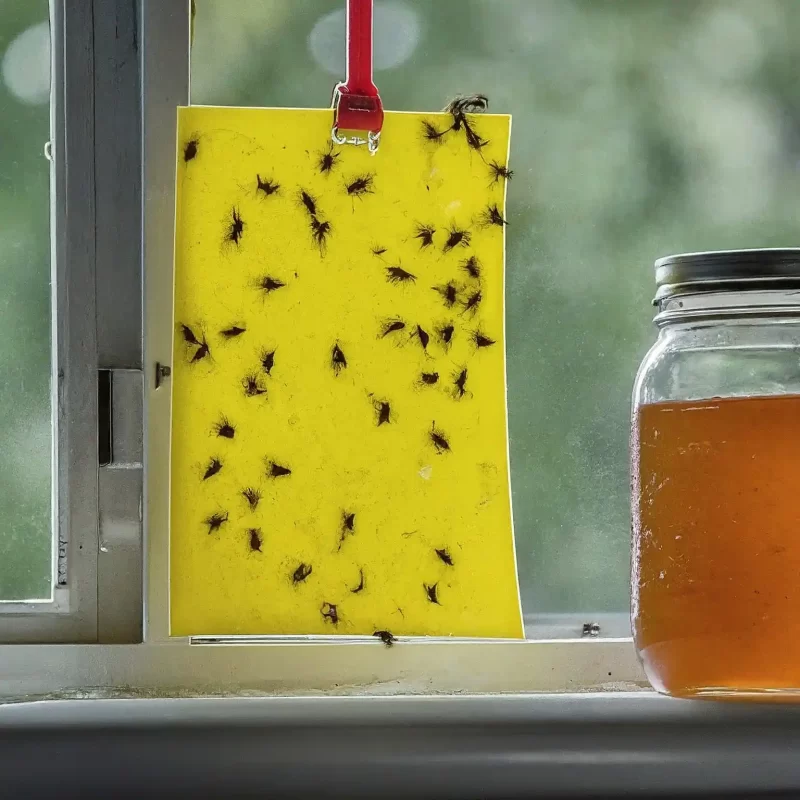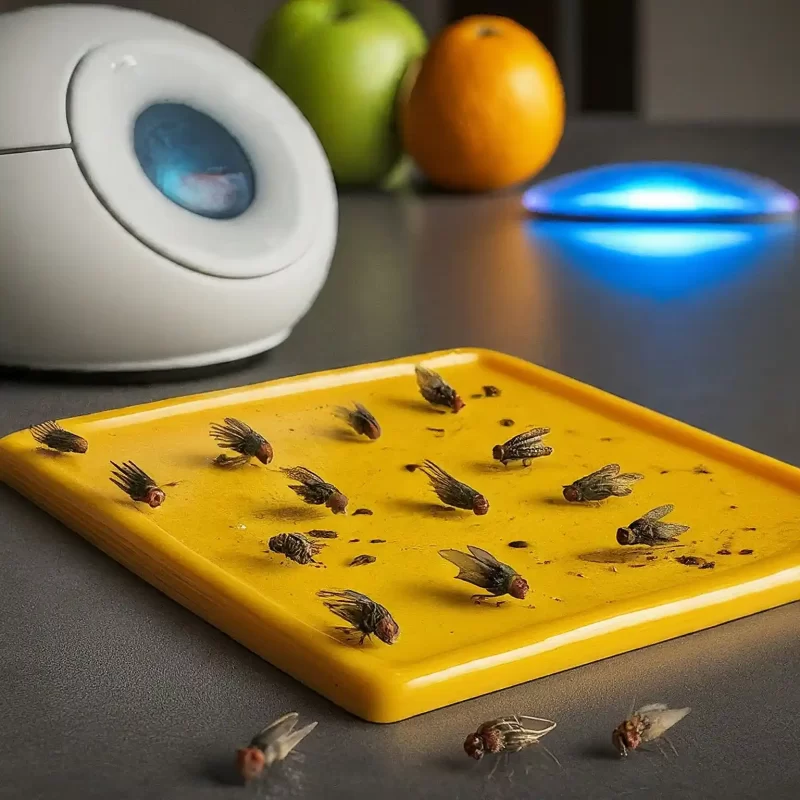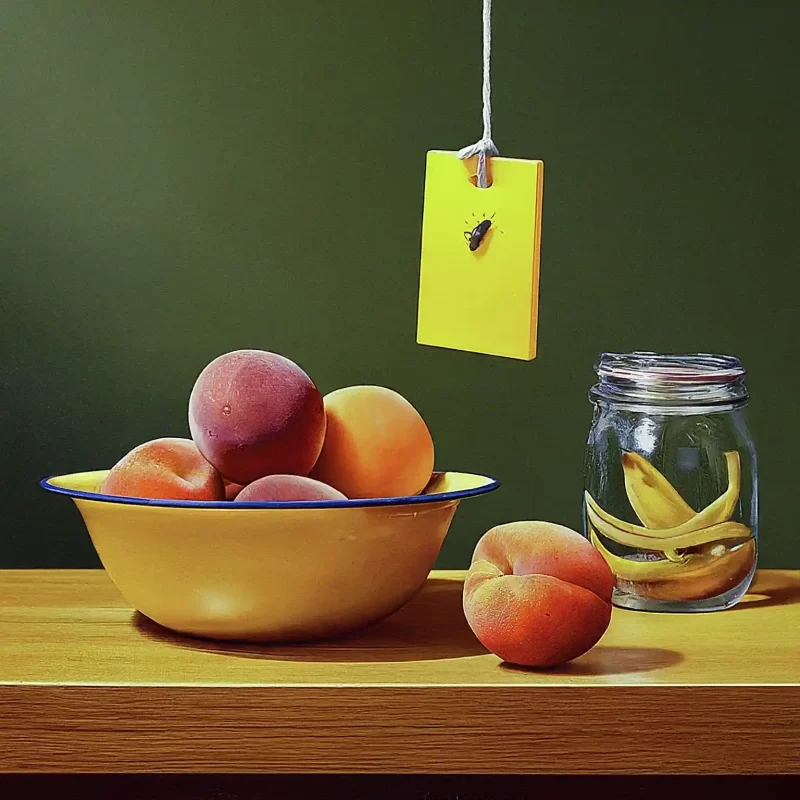Fruit Fly DIY Guides
5 Tips Use Fruit Fly Yellow Sticky Traps
Fruit fly yellow sticky traps offer a simple way to combat annoying fruit flies. These pesky insects can ruin dining experiences in restaurants and hover over ripening fruit in kitchens. Yellow sticky traps provide an effective and easy-to-use solution for trapping and eliminating these unwanted visitors.
Key Takeaways:
- Sticky fruit traps exploit the visual behavior of fruit flies to lure and trap them. This inherent attraction makes yellow sticky traps an effective fruit fly control method.
- Yellow sticky traps offer a non-toxic and economical solution for monitoring and managing fruit fly populations. They are safe to use around children and pets, and their affordability makes them a practical choice for both residential and commercial settings.
- Strategic placement and timely replacement of traps are essential for maximizing their effectiveness. Traps should be positioned in areas with high fruit fly trap activity, and replaced regularly to maintain their visual appeal and trapping capacity.
- To achieve optimal results, yellow sticky traps should be used in conjunction with sanitation measures that eliminate fruit fly breeding grounds. This comprehensive approach ensures long-term fruit fly control.
How Fruit Fly Yellow Sticky Traps Work

Fruit flies are inherently drawn to the bright yellow color, which in nature is often associated with ripening fruits, their primary food source. This innate visual attraction makes yellow sticky fruit fly traps highly effective. The traps themselves are coated with a strong adhesive that ensnares flies upon contact, effectively removing them from the population. Some trap variants may incorporate additional attractants, such as pheromones, to further enhance their effectiveness by mimicking the scents of ripe fruits or even attracting male flies.
Read More: The Lifecycle of Fruit FliesBenefits of Using Fruit Fly Yellow Sticky Trap
1. Non-toxic
Fruit fly yellow sticky traps are a safe option for use around people and pets. They don’t contain any harmful chemicals or insecticides, making them ideal for restaurants and households with children or pets. This is a significant advantage over traditional fly swatters or chemical sprays, which can pose a health risk if not used properly. Additionally, yellow sticky traps won’t leave behind any unpleasant odors or residues.
2. Cost-effective
Yellow sticky traps are a relatively inexpensive way to control fruit fly populations. They are readily available at most grocery stores and online retailers.
3. Monitoring tool
The number of flies caught in the traps provides a valuable indication of the severity of a fruit fly infestation. This allows for targeted control measures to be implemented.
4. Easy to use
Fruit fly yellow sticky traps require minimal setup and maintenance. Simply peel off the protective backing from a trap measuring around 3 inches by 5 inches. For hanging, use the pre-cut slot or punch a hole at the top of the trap and thread a string or twist tie through it. Position the trap in strategic locations.
Tips for Effective Use of Yellow Sticky Traps

1. Placement
For optimal results, position traps near areas where fruit flies are most active, such as around ripening fruits, garbage disposal units, and recycling bins. Hang traps at eye level for maximum visibility to flies.
2. Multiple Traps and Types
Don’t rely on a single trap. Use multiple traps strategically placed throughout the infested area for better control. Consider using a combination of trap types. Some traps come pre-baited with a lure, while others rely solely on the visual attractant of the yellow color. Experiment to see which type works best in your situation.
3. Trap Maintenance
To maintain the effectiveness of fruit fly yellow sticky traps, replace them regularly, especially when they become significantly covered with dead flies. The visual appeal of the trap diminishes as it fills with insects, and the accumulated bodies can obstruct the sticky surface, reducing its ability to capture new flies exclamation.
4. Combination Approach
While effective, yellow sticky traps alone may not completely eradicate a fruit fly infestation. Combine their use with proper sanitation practices to eliminate breeding grounds. Here are some additional tips:
- Store ripe fruits in the refrigerator.
- Promptly dispose of overripe or decaying fruits and vegetables.
- Clean up spills and sugary residues around garbage cans and disposal areas.
- Empty and clean trash cans regularly.
- Repair leaky pipes or faucets that may create moisture buildup.
Limitations of Fruit Fly Yellow Sticky Trap
- Non-discriminatory: Fruit fly yellow sticky trap attract and trap not only fruit flies but also other flying insects. This may not be ideal in situations where beneficial insects are present, such as in gardens or greenhouses.
- Limited reach: Traps only capture flies that come into direct contact with them. They may not be effective for widespread infestations.
- Aesthetic considerations: While discreet options exist, yellow sticky traps can be visually unappealing in some settings.
Alternatives to Yellow Sticky Traps
- Homemade traps
Create a DIY trap using a container filled with a mixture of apple cider vinegar, a few drops of dish soap, and a sprinkle of sugar. The sweet scent attracts the flies, and the soap disrupts their surface tension, causing them to drown in the liquid.
- Natural repellents
Plants like basil, lavender, and citronella are said to repel fruit flies. While the scientific evidence for their effectiveness is inconclusive, these options provide a non-toxic approach and may be worth trying in certain situations.
Read more: 10 Eco-friendly Ways to Make Natural Fruit Fly Traps- Professional pest control
For severe infestations, particularly in restaurants with health code regulations, consulting a professional pest control service is the most effective solution. Professionals can identify the source of the infestation and implement targeted measures to eradicate it.
Conclusion
Yellow sticky traps provide a dependable, budget-friendly, and hassle-free solution for managing fruit fly populations in restaurants and home kitchens. By understanding their advantages, limitations, and proper use in combination with sanitation practices, you can effectively gain control of these bothersome insects and preserve a pleasant environment.

Hi there! I’m Beliz Güner, and welcome to my world of innovative solutions for fruit fly challenges. Though I hail from Turkey and have a background in interior design, my true passion lies in tackling the persistent issue of fruit flies. My journey has been anything but ordinary, as I’ve transitioned from creating beautiful spaces to devising effective fruit fly traps.
My interest in DIY home projects and product reviews has fueled my desire to share knowledge and personal experiences with others facing similar frustrations. Through my blog, I aim to empower you with the tools and insights needed to combat fruit fly invasions, drawing on my unique blend of design creativity and hands-on experimentation. Join me as we explore the most effective strategies to reclaim our homes from these unwelcome guests.


Wow, I never knew you could get rid of fruit flies this easily! I’ve been struggling with them in my kitchen for weeks. Can’t wait to try this method!
Glad you found it helpful! Feel free to reach out if you need more tips!